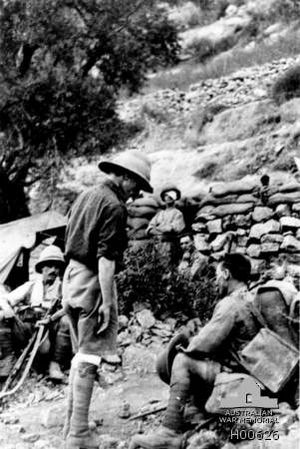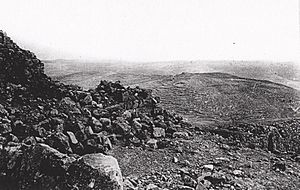Battle of Nebi Samwil facts for kids
Quick facts for kids Battle of Nebi Samwil |
|||||||
|---|---|---|---|---|---|---|---|
| Part of the Middle Eastern theatre of World War I | |||||||
 Nabi Samwil |
|||||||
|
|||||||
| Belligerents | |||||||
| Units involved | |||||||
| XXI Corps | Seventh Army | ||||||
The Battle of Nebi Samwil was an important fight during World War I. It happened from November 17 to 24, 1917. This battle was part of a bigger effort by the British Empire to capture Jerusalem from the Ottoman Empire.
It took place after the British forces, called the Egyptian Expeditionary Force (EEF), had won several other battles. These included the Battle of Beersheba, the Third Battle of Gaza, and the Battle of Mughar Ridge. The Battle of Nebi Samwil was the first time the British tried to capture Jerusalem itself.
The village of Nebi Samwil (now called Nabi Samwil) was a key part of the Ottoman defenses. Capturing it was seen as very important for taking Jerusalem. The British attacked with three divisions: two made of infantry (foot soldiers) and one with mounted troops (soldiers on horseback).
The 234th Brigade, part of the 75th Division, captured the village on November 21, 1917. However, they had to defend it almost every day from Ottoman counter-attacks. Without their heavy weapons, the British soldiers could not break through the main Ottoman defense line. Because of this, the attack did not reach its goal of capturing Jerusalem.
Why the Battle Happened
In November 1917, the British Egyptian Expeditionary Force, led by General Edmund Allenby, had beaten the Ottoman Empire's forces. This happened in the Third Battle of Gaza and the Battle of Mughar Ridge. The British were chasing the retreating Ottoman army.
On November 14, the 75th Division captured Junction Station. This cut the railway line to Jerusalem and gave the British fresh water. It also split the Ottoman Seventh and Eighth Army. The next day, the ANZAC Mounted Division captured Ramleh and Ludd. On November 16, the New Zealand Mounted Rifles Brigade captured the port of Jaffa.
In just ten days, the British had advanced about 60 miles (97 km). But they had also lost 6,000 soldiers. The number of Ottoman soldiers killed is not known, but 10,000 were captured. The British also took 80 artillery pieces and 100 machine guns. Even with these losses, most of the Ottoman armies managed to retreat. However, they were split, making it hard for them to support each other. The Ottoman Seventh Army was also cut off from the railway, so all their supplies had to come by road.
General Allenby planned to cut off Jerusalem from its supply routes to the north. Two infantry divisions, the 75th Division and the 52nd (Lowland) Division, would move towards Jerusalem. The horsemen from the Yeomanry Mounted Division would be on the right. The 75th Division would use the main Jaffa–Jerusalem road. The two outer divisions would circle Jerusalem and meet at Bireh, about 10 miles (16 km) north of the city.
The village of Nebi Samwil was in the way of the 75th Division. It is also known as the "Tomb of Samuel". Nebi Samwil sits on top of a hill 2,979 feet (908 m) above sea level. It is about 3.1 miles (5 km) north of Jerusalem. From the village, observers could see into Jerusalem. It also controlled the road from the coast to the west and the road from Samaria to the north. The village was a key part of the Ottoman defenses. Capturing it was very important for taking Jerusalem.
The Attack Begins
The attack started on November 18. The Australian Mounted Division first cleared Latron, which was in the path of the 75th Division. The next day, the Yeomanry Mounted Division, which had the furthest to go, moved first. Then came the 52nd (Lowland) Division from Ludd and the 75th Division from Latron.
The two divisions traveling on rough tracks found it hard. Their vehicles and heavy weapons had to turn back. The advance also happened at the start of winter rains. This made the ground difficult and caused problems for the soldiers. They were only ready for desert fighting and did not have winter clothes.
However, the 52nd Division reached Beit Likia. The Yeomanry Division reached Beit Ur el Tahta by the end of the first day. The 75th Division, using the only good road, made good progress. They fought through Ottoman defenses on hilltops. They captured the villages of Saris and Kuryet el Enab on November 20. They took Saris in the afternoon and Kuryet el Enab before nightfall. They used an infantry attack under the cover of thick fog. But they had only met the Ottoman rearguard. The main Ottoman force was still ahead.
Elsewhere, the 52nd Division made some progress. But the Yeomanry faced a strong position of 3,000 Ottoman soldiers. These soldiers were supported by artillery on the Zeitun ridge. The Yeomanry briefly captured the position but were forced back on November 21.
On the same day, the 75th Division changed its attack direction. They moved north-east towards Biteh to meet the mounted division. The division was stopped at Biddu and the heights of Nebi Samwil. After fighting all day, the 234th Brigade finally took the village that evening. However, the two infantry divisions were now stuck. They could not make any more progress.
The British attack continued the next day, November 22, against El Jib. But both infantry divisions needed more soldiers. They also had no artillery support, as the heavy guns could not get up the mountain tracks. They fought for three days but could not break through the main Ottoman defense. The attack stopped. For the next two weeks, the Ottoman army tried to retake Nebi Samwil. The British captured 750 prisoners during this time. The Ottoman army suffered many losses trying to retake the village. This made it harder for them to stop the next British attempt to take Jerusalem.
General Bulfin asked for the XX Corps to take over the line because his soldiers had suffered many losses. By November 28, the XX Corps had taken over the positions from the XXI Corps. The efforts of the 52nd and 75th divisions helped the British gain a foothold in the difficult Judean hills. This allowed General Allenby to plan a new attack to capture Jerusalem.
After the Battle
- Further information: Battle of Jerusalem (1917)
The British first attempt to take Jerusalem failed for a few reasons. They lacked artillery support and needed fresh troops. The bad weather conditions and the strong Ottoman defense also played a part.
Before their next attack, the British improved the roads and tracks in the area. This helped them bring forward heavy artillery, ammunition, water, and other supplies. Allenby also decided to replace the XXI Corps with the XX Corps, which had been in a quieter area.
The Ottoman Army did not just wait. They launched several attacks against the British forces in late November and early December. British reinforcements arrived and stopped the Ottoman attacks. The British then went on the attack themselves on December 7. The Ottoman forces left Jerusalem during the night of December 8/9. The city leaders then handed Jerusalem over to the British.
For their part in the battle, the 75th Division's symbol became a key. This showed that the battle was the key to capturing Jerusalem. The British Empire regiments involved were given the battle honour Nebi Samwil to recognize their role in the battle.





